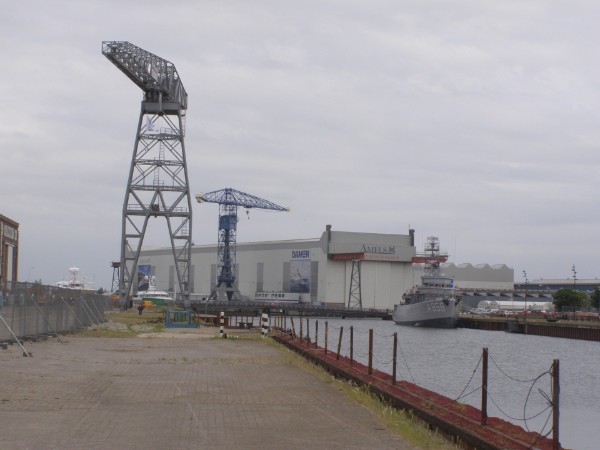Vlissingen and Royal "De Schelde"-wharf
Vlissingen in short
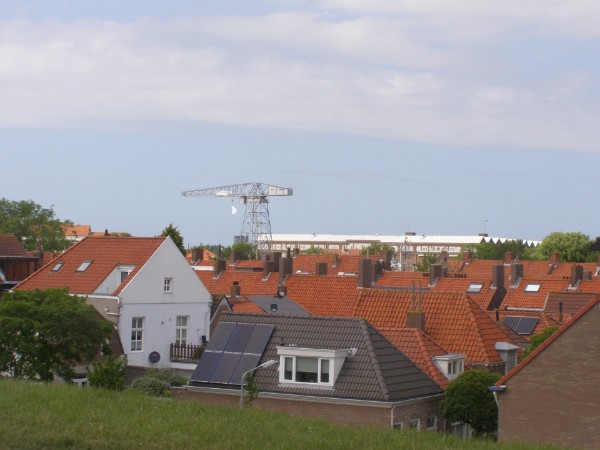
Vlissingen is a 33.000 populus town in the province of Zeeland in the south of The Netherlands. Yes, this region gave the name New Zealand to those islands close to Australia, that is why it isn't called New Sealand. The town has a very strategic location at the mouth of the Westerschelde, which is the gateway to the port of Antwerp in Belgium. Actually, both sides of the Westerschelde estuary are Dutch, so the Belgians can be very happy that we are quite friendly towards them. Except for the jokes, then... Back to Vlissingen. In English, the translated name of the town is Flushing. Yes, that's where the neighborhood in Queens, New York was named after, as well of course as Flushing Meadows. Then there is also a Flushing in Ohio and a Flushing in Mitchigan (which was named after Flushing in Queens). So you can see that several places in the world were named after Vlissingen and the region of Zeeland, showing how important those two have been in history. For name-geeks, the original name Vlissingen probably comes from the Dutch word for 'bottle' which is now 'fles' but used to be written as 'vles'. In the 7th century, the missionary Saint Willibrord came to Vlissingen and shared the water within a bottle with several beggars in town. A miracle happened and the bottle didn't deplete so, because the beggars weren't interested in his words he just gave them the bottle and named the town Flessinghe. Another story is that as due to supersticious reasons a bottle was hung at the ferryhouse located here and when a monk visited the ferryhouse in the year 967 he named the ferryhouse 'het veer aan de fles' of 'the ferry by the bottle'. A lot of tows at that time ended their name at -inge so it later changed to Vles-inge. But a bottle it was that gave the town it's name.
In Normany there are the D-Day beaches, but in Vlissingen there is Uncle Beach, from where allied forces started to liberate the Zeeland region from the other side of the Westerschelde estuary. This statue of the 4th Regiment remembers those who fell during these landings in 1944. The town of Vlissingen was decimated in the war. In 1940 the town had 24.000 inhabitants, in 1945 just 3.000. Only one house was undamaged during the war.
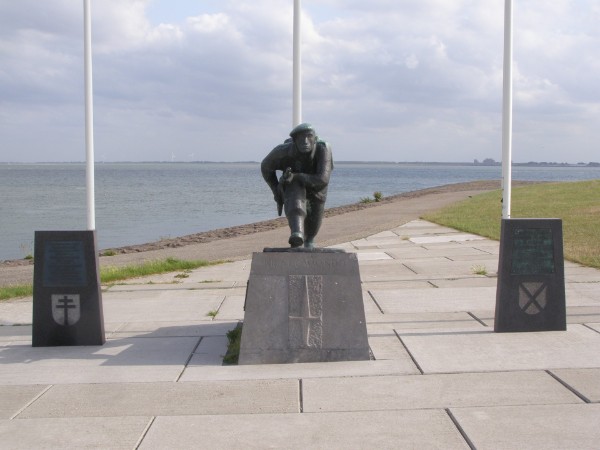
That all of course is related to the place where the town is situated, on the mouth of one of the more important rivers of Europe, the Schelde. In 1572, Vlissingen was the second town in The Netherlands to get rid of the Spanish in the so-called eighty-year war and between 1585 and 1616 it was in fact an English town as it was given as collateral to the English for their military and financial help during the rest of the war with the Spanish. In 1808, the town became French just before the French invaded The Netherlands and this lasted untill 1815 when the current Kingdom of The Netherlands was established.Again, the towns popularity by invading forces of other Kingdoms is mostly again it's location.
Shipping
Now the thing we are here for, shipping. Being in such a good place, Vlissingen has always been one of the main ports and shipbuilding sites in The Netherlands. As we see in the story of the monk, a ferryhouse was supposed to be here already before the year 1000. More recent, in 1875 the company Stoomvaart Maatschappij Zeeland started a ferryservice to England from Vlissingen which ended in 1939 due to the war. Because of a lot of damage in the port of Vlissingen, the route was relocated to Hoek van Holland after the war and never returned, later absorbed into Stena Line in 1989. Between 1974 and 1994, the company Olau Line revived the ferryservice to Sheerness, but it was ended because of growing competition and the new Chunnel which had a large impact to smaller ferryservices across the North Sea.
Another ferry-route of course is sailed between Vlissingen and Breskens at the other side of the Westerschelde estuary. This 'modern' version of the ferryserice started in 1574 and is now since 1993 sailed as a foot- and bikeservice only, losing the carferries because a new tunnel has been opened way, way further upstream. Two modern but smaller ferries are now sailing the route, the Prins Willem Alexander and Prinses Maxima (now both King and Queen actually although the ships have never been re-named after the crowning).
Prins Willem Alexander is seen leaving the port of Vlissingen for Breskens at the 3rd of june in 2019.
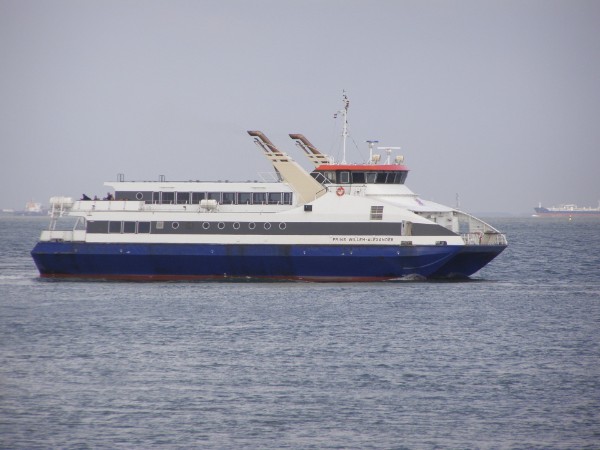
In 2010, The Prinsendam of the Holland America Line was the first cruiseship to dock in Vlissingen at the former ferryterminal. In 2011, Phoenix Reisen's Albatros followed. The port is not yet a true cruiseport, but ocasionally cruiseships find this historic port with it's many monuments, great seaviews, old dockyards and shipping history. And so they should.
Vlissingen also is the homeport of a relatively new Dutch cruiseline, founded in 1996. Oceanwide Expeditions sail a fleet of expedition cruiseships and sailingyaughts to the most remote places in the world. They do not come in regularly, but Vlissingen is their homeport and their ships can be seen in port sometimes. In 2019, they named their newest ship Hondius in port, although this happened at the new Eastern docks, located far away from town upstream.
Below, Oceanwide Expeditions' newest ship Hondius passes "De Punt" at the same day.
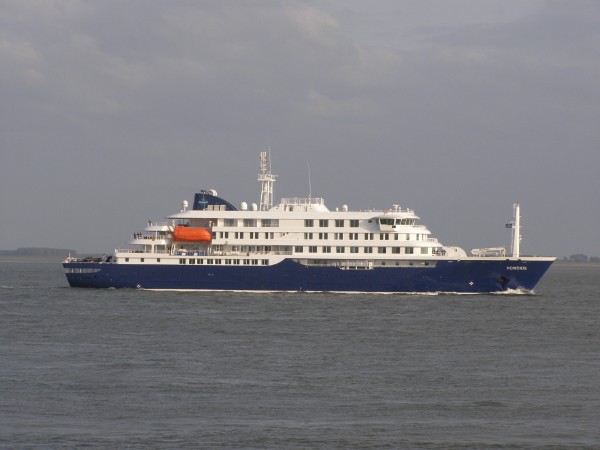
Royal "De Schelde" yards
Vlissingen is almost synonimous with the Royal "De Schelde" dockyards and the town bares it's glory and it's scars to this very day. The wharf was officially founded under this name at the 8th of october in 1875 by Arie Smit, whose grandfather Fop Smit had already been involved in shipbuilding since 1838. You might recognize the name Smit as he also was the founder of the now worldwide acclaimed Smit Tugs. In the year 1838, Fop Smit met a man named Willem Ruys who had ordered a ship from his yard at Kinderdijk which he named Cornelis Wernard Eduard. The ship was a barque meant for the trade with the Dutch East Indies. Ruys really appreciated the ship that Fop Smit had built for him and he ordered many more ships from the wharf at Kinderdijk and a friendship between the two men started. Ruys even named ships after the shipbuilder, in 1852 the first Fop Smit took to the water and in 1871 a second Fop Smit followed.
The former main office of the Royal "De Schelde" shipyards is one of the buildings remaining on the site where the mighty wharf once stood. It was built in 1913 and is still in use as the head office of Damen Schelde Naval Shipbuilding.
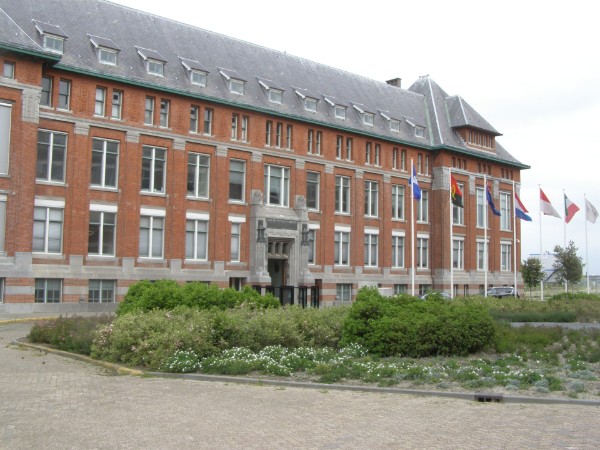
The company W. Ruys & Zonen (after his sons also entered the trade) flourished and a large fleet was built up, mainly sailing for the Dutch Indies. The first steamship they ordered came in service in 1870 as Ariadne and it was in fact this 1297-ton ship that made the first sailing from Rotterdam to New York in july of 1872 under charter to the Holland America Line as their first ship Rotterdam had not been ready on time for the sailing. A few years later, not really by co-oncidence as the same years where-in the "De Schelde" Yards were founded, Ruys formed the Rotterdamsche Lloyd company, which gained a very high reputation for the next century. One of the main reasons that the Smit family started the large wharf at Vlissingen was because the Ruys family had ordered their first steamships from English and Scottish wharfs due to the know-how there. Arie Smit knew he also was capable of building steel steamships and he told Willem's son Willem Ruys (they really liked the name Willem), after he had bought the former navy-yard that was originally located in Vlissingen, he could build ships as good and as cheap as the English and if Ruys didn't liked the ships he would take them back without Ruys having to pay even a penny for them. Of course Ruys agreed. So the first larger ships that were built at "De Schelde" were two ships for the Rotterdamsche Lloyd, the Batavia and the Soerabaja. One more ship was built in England, but furthermore, the new Vlissingen yards became the house-wharf of the Rotterdamsche Lloyd and was thus assured for a steady stream of orders becoming one of the most important shipbuilding wharves in The Netherlands.
The Dock of Perry is the oldest drydock in The Netherlands and one of the oldest in Western Europe. It was built between 1704 and 1705 to a design by the Englishman John Perry. So this little dock predates the Schelde shipyards by some 170 years, showing that naval shipbuilding was going on long before that wharf was established in 1875. The larger dock it is connected to was even dug all the way back in 1614. Perry was also a Captain in the Royal Navy but as he lost his right arm in battle after a fight with the French in 1690. Three years later he again fought with the French but then lost his ship. He was arrested and sentenced as a coward for which he had to do jailtime for ten years but released in 1697. Then the province of Zeeland approached him to design a dock and afterwards he went to Saint Petersburg, Russia where he designed a whole bunch of docks and shipyards. So he turned out pretty well...
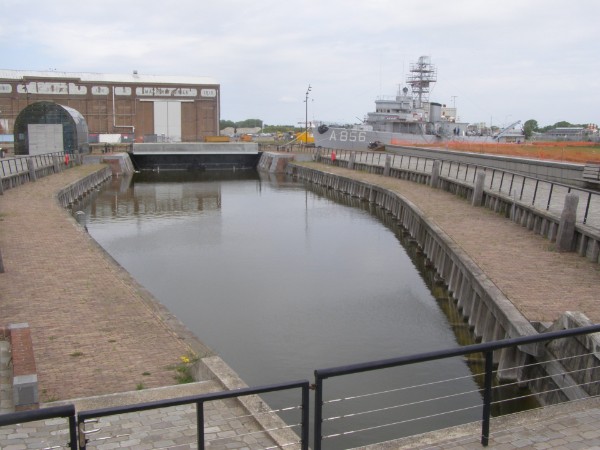
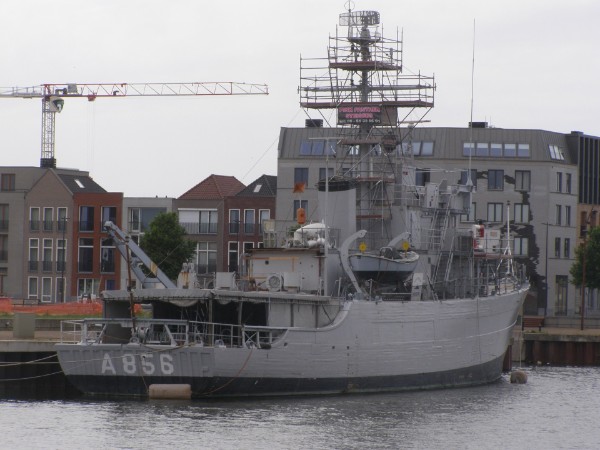
As a memory to the naval shipbuilding in Vlissingen, the small 1950's-built A856 HrMs Mercuur is docked right next to the Dock of Perry. She is a torpedo-workship and designated to become a museum soon to come.
Over 400 ships have been built by the wharf since its founding in 1875. First on outside docks and later on large covered shipbuilding halls. Due to the growth of the company, a large part of the historic town of Vlissingen was demolished for extended factories. The company was not only involved in shipbuilding, but also tried to get a piece of the aircraft industry (even designing its own aircraft which by the way weren't very good or popular). They also built dieselengines, steamturbines and later motors and one arm of the company started to fabricate light-metals like aluminium. For the Dutch National Railways also several busses were built just after the second world war. Most important ships built at the wharf in Vlisisngen are the Rotterdamsche Lloyd liners Indrapoera (1926), Sibajak (1928), Baloeran (1930), Dempo (1931) and Willem Ruys (between 1939 and 1947). Also the Kungsholm for Swedish American Line was built at Vlissingen in 1953 as well as parts for Holland America's Nieuw Amsterdam of 1938. The wharf also constructed of course most of the ferries for the ferryservices at the Westerschelde as well as the ships for the Stoomvaart Maatschappij Zeeland. Next to all civil ships, the wharf also became the most important wharf for the building of naval ships for the Dutch navy, including submarines.
Below is shown all that remains of the large slipways on which the wharf laid down the ships. Most iconic of course is the Willem Ruys, later the cruiseship Achille Lauro. She was laid down in 1939 but because of the war she remained on the slipway untill 1946. Although the whole town of Vlissingen was decimated in bombings, this huge towering hull was staying relatively undamaged. Although the Germans tried to launch the ship, this was always sabotaged by the Dutch resistance. Her hull became a symbol of Dutch courage and determination and she of course had a long carreer for Rotterdamsche Lloyd afterwards.
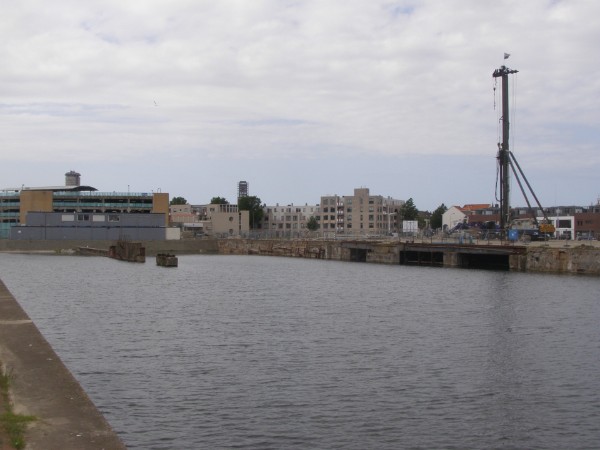
Also shiprepair became a very important part of the wharfs portfolio and in 1960 they bought a large chunk of land in the newly created Eastern docks of Vlissingen, far away from the town center. The new wharf here opened in 1964.
Very recently, just in may of 2019, this crane was replaced to the dockside where the ships were finished after their launch. I was very happy to see this crane in full glory again, as it is considered a true landmark for the history of the town of Vlissingen and the shipbuilding in general. Behind the crane you can see the large engine-works building, which is also intact.
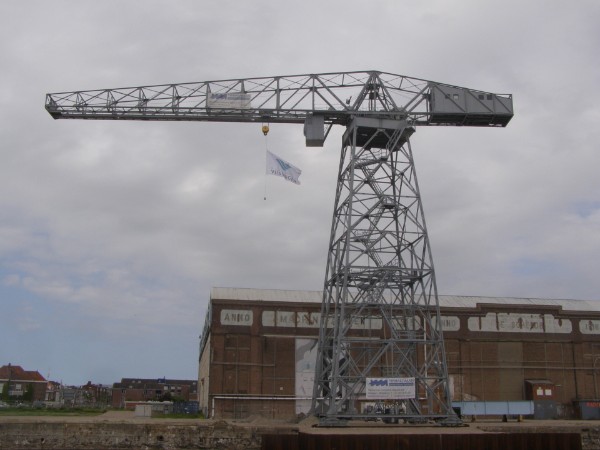
Most shipbuilding activities slowly started to vanish from Vlissingen at the end of the 20th century. In 1965 the wharf had merged with the Rotterdamsche Droogdok Maatschappij in Rotterdam and the NV Motorenfabriek Thomassen in De Steeg into Rijn-Schelde Machinefabrieken en Scheepswerven NV, in 1971 more extended with the Verolme Verenigde Scheepswerven NV. In the year 2000, after the Dutch state had bought the stocks of the company, it was sold to Damen Shipyards Group in Gorichem, creating what now is one of the largest shiprepair groups in the world. Damen now had many repairyards and created their newbuildingdepartment mostly in Romania. There is a little hope that shipbuilding may come back to Vlissingen one day, but that has to be seen. So when you now read the name Damen you know where their origins come from.
Aft of the old crane, the new Damen repairyards are shown. Here the yaughtbuilder Amels repairs the worlds largest private yaughts.
